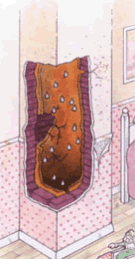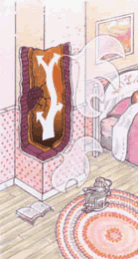|
|
|

| |
 |
|
|
Chimneys are an integral part of most home heating systems. A masonry chimney is composed of several components, each playing an important role in the performance and function of the chimney, regardless of the fuel utilized or the heating appliance that is used. One of the most important, and perhaps least understood, of these components is the flue lining.
Chimney Liners
3G Chimney, LLC has been servicing Northwestern Connecticut, CT for over 25 years.For over 25 years we have been delivering excellent service and quality work at fair prices across Connecticut, CT. 3G Chimney is the only source for CSIA Certified Sweeps in Northwestern Connecticut, CT.
Flue Lining
A flue lining of a chimney is defined as
"A clay, cast concrete or metal conduit installed inside of a chimney, intended to contain the combustion products, direct them to the outside atmosphere, and protect the chimney walls from heat and corrosion."
A wise homeowner will want to know about the condition of the chimney, including the flue lining, in the home he owns or plans to buy. This information can be supplied by a CSIA Certified Chimney Sweep®. Although codes and building practices may vary from one state or locality to another, the installation of flue lining in chimneys has been recommended since the early part of this century. It should be noted however that many chimneys built since then have not included a flue lining.
Terra-Cotta Flue Tile
The most common material used as a lining for masonry chimneys in a new construction is terra-cotta clay flue tile. It is a relatively inexpensive and easily obtainable product. Lining products made of other materials, such as ceramics, metal, and cast concrete, are preferred and may be used in a new construction. These alternatives are most commonly used in upgrading chimneys built with improper linings, those with damaged or oversized linings, or those originally built without the benefit of any type of lining. |
|
|
|
|
|
"But my furnace chimney looks fine on the outside."
 Many chimneys venting gas or oil furnaces or hot water heaters may appear to be in fine condition on the outside. But inside it could be a completely different situation. Yesterday's chimneys were not designed for venting today's more energy efficient appliances. Let's take a close look at what really counts...the inside. Many chimneys venting gas or oil furnaces or hot water heaters may appear to be in fine condition on the outside. But inside it could be a completely different situation. Yesterday's chimneys were not designed for venting today's more energy efficient appliances. Let's take a close look at what really counts...the inside.
Now look inside, see the problems?
A look at the inside of this same chimney shows how acid-laden residue from the furnace has attacked this flue. The original clay liner has eroded away; pieces of it are even missing. (Old chimneys might not even have a liner.) Mortar and bricks are loose and falling, and moisture has leeched through to the home's interior walls.
With continued use, more erosion will take place, possibly leading to leaks in the flue, complete flue blockage, or possibly even carbon monoxide poisoning of the home's occupants
 Chimney problems can cause illness and even loss of lives. Chimney problems can cause illness and even loss of lives.
It's happened thousands of times - illness, even death, from carbon monoxide or sulfur dioxide poisoning.
With deterioration of the flue, the deadly gases can find their way into your home through even the smallest cracks.
In severe cases, the chimney erosion will lead to partial or complete internal collapse, blocking the flue and sending these poisonous gases into the home.
But fortunately, the problems of a deteriorating gas or oil furnace flue can be corrected without completely rebuilding your chimney. |
|
|
|
|
|
What causes water in a gas furnace flue?
The modern, high-efficiency gas furnace is a fabulous engineering marvel. In the old days, low-efficiency gas furnaces sent almost as much heat up the chimney as they put into your home. This pushed your utility bills sky-high and wasted precious natural resources.
Today's high-efficiency gas furnaces extract more heat during the burning process and send much less of it up the flue. But for all the benefits these furnaces offer, there's one important side effect that must be dealt with - excessive moisture in the flue.
You see, water is a byproduct of burning. In fact, when you burn 1 cubic foot of gas, you create 2 cubic feet of water vapor. Those old, inefficient furnaces sent so much heat up the flue that the water created in the combustion process stayed in the form of hot steam all the way up and out the chimney.
New high-efficiency furnaces don't put as much heat into the flue; they put it into the home where you want it. The problem is, the water vapor that's created during burning now doesn't have the draft power to push it up and out your furnace flue. So what happens? It condenses on the walls of your chimney. And, unfortunately, no chimney is designed to be constantly bathed with water, especially the acid-laden water that is found in your furnace flue.
The result is the deterioration we've outlined in the middle of this brochure. Installing a new, high-quality 316 Ti-alloy or AL 29-4C stainless steel HomeSaver Chimney Liner will vent these water vapors efficiently and with maximum safety.
Some common symptoms of excessive moisture in a gas furnace chimney
Inside
-
Peeling wallpaper
-
Blistering paint
-
Flaking plaster
-
Ceiling stains
-
Damp patches
-
Mold
Outside
-
White stains on brick
-
Eroded mortar joints
What problems result from sulfur compounds in an oil furnace?
While we commonly think of a masonry chimney as a permanent structure, practically impervious to damage, that's not the case. Without a proper liner and annual maintenance, the toll can be a heavy one.
When the oil you heat with is burned, sulfur soot is formed on the inner wall of your chimney.
This sulfur-laden soot combines with moisture in the flue, a natural byproduct of today's highly efficient furnaces. This forms an acid mixture which attacks your chimney, eroding your flue tiles and mortar joints.
This leaves dangerous voids and allows the sulfuric acid mixture to attack the brickwork, your last line of defense against deadly sulfur dioxide and carbon monoxide poisoning. Additional danger exists as the chimney debris, or silt, falls to the bottom of your chimney. This can eventually plug the chimney, allowing dangerous gases to enter your home.
Installing a new, high-quality 316 Ti-alloy or AL 29-4C stainless steel HomeSaver Chimney Liner will vent this dangerous sulfur soot efficiently and with maximum safety.
Some common symptoms of problems in an oil furnace chimney
Inside
-
Silt in chimney
-
Soot floating in the house
-
Soot coming from barometric damper
-
Odor
-
Flaking plaster
-
Damp patches
Outside
-
White stains on brick
-
Eroding mortar joints
-
Deteriorating bricks
|
|
|
|
|
|
Revitalize your chimney with a HomeSaver® Chimney Relining System
 HomeSaver will revitalize your chimney. We suggest a liner that is made of either 316Ti alloy stainless steel or AL294C alloy stainless steel, depending upon your type of furnace. These alloys were developed specifically to resist corrosive flue acids. A liner acts as a barrier between the flue gases and the defects in your chimney walls. HomeSaver will revitalize your chimney. We suggest a liner that is made of either 316Ti alloy stainless steel or AL294C alloy stainless steel, depending upon your type of furnace. These alloys were developed specifically to resist corrosive flue acids. A liner acts as a barrier between the flue gases and the defects in your chimney walls.
Not only will it add to the safety of your home and family, it will also increase the resale value of your home. And, your furnace will run more efficiently.
HomeSaver's patented construction is unsurpassed in flexibility and strength. This dependable, high-quality product comes with the best lifetime warranty in the industry.
HomeSaver can reline virtually any chimney configuration you may have - from single, straight flues, to multiple flues and flues with bends prednisone and size changes. Talk to your HomeSaver installer today for all the details. |
|
|
|
 |
|
|
| |
| |
|
|
|



